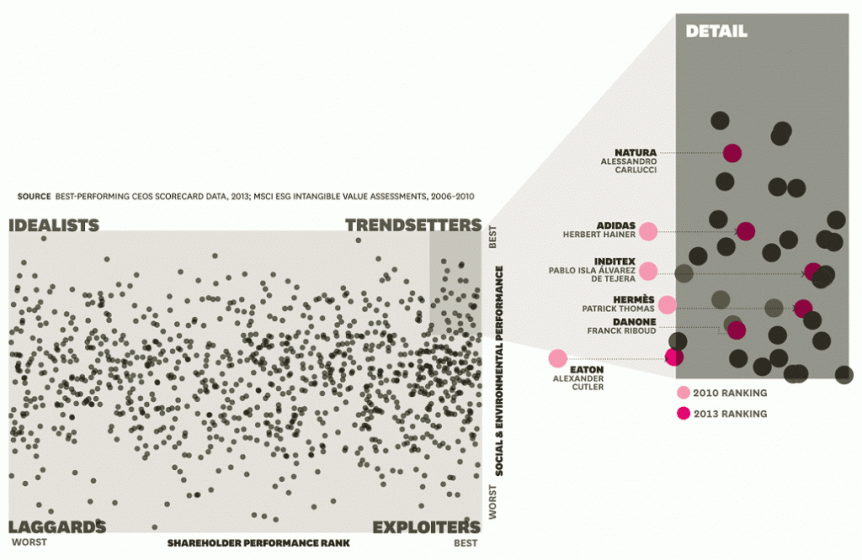Can companies both do well and do good?
Morten T. Hansen, Herminia UIbarra and Urs Peyer
24 January 2013
Many management thinkers argue that it is no longer enough to do well financially; companies also need to improve the well-being of (or at least not harm) the communities in which they operate, the environment, and their employees. (See, for example, Creating Shared Value, by Michael E. Porter and Mark R. Kramer.) That’s the good news. The bad news is that stellar performance on both dimensions is no common or easy feat.
This year we examined the correlation between the financial performance of leaders on our list and their social and environmental performance as measured by MSCI, a highly reputable firm that rates major companies. Despite all the rhetoric, we discovered that the correlation between the two sets of data is, well, zero. You can see this clearly in the graphic below, which maps the long-term financial performance of some 1,100 CEOs against their companies’ social and environmental performance for their last two years in office.

Companies are scattered all over this chart. Though many articles suggest that responsible corporate behavior — say, in sustainability — will automatically improve your bottom line, clearly it’s not as simple as that. Some companies probably aren’t managing with such issues in mind. Some may not have attractive social or environmental strategies; some may have misalignment between those strategies and the overall corporate strategy; and some may have incomplete measures of social or environmental practices.
But the chart did reveal outliers. 5% of the CEOs for which we had sufficient data fell into the box at the top right; they delivered great financial performance year over year and performed strongly on social and environmental dimensions. It is a rare achievement, indeed, but it is possible.
These trendsetting CEOs are the new role models for leaders pursuing the paradigm of creating shared value. One example: Franck Riboud of Danone, a French multinational with $27 billion in annual sales. Danone’s excellent financial performance earned him a spot in the top 10% of this year’s sample (a truly amazing achievement for a consumer goods company); at the same time, the company received extremely high ratings from MSCI. Another outlier is Natura’s Alessandro Carlucci (who made the top 6% for financial performance), a leader among CEOs who believe that alleviating poverty and inequality and protecting the environment are intimately tied to their business agendas. Carlucci and Riboud have both confronted the key social or environmental issue in their industry (in Danone’s case, obesity and unhealthful food consumption; in Natura’s, deforestation and poverty) and redirected their company’s strategy to tackle it.
We also looked at CEOs whose companies had high social and environmental performance in 2010 but whose financial performance kept them out of the top 15% of the group studied that year. Since doing both well and good can be a long-term strategy, we wanted to see whether any of those CEOs had then moved into the top 15% of the current financial ranking. We found four: the leaders of Adidas, Inditex, Hermès International and Eaton.
At Adidas, CEO Herbert Hainer oversaw the implementation of a triple-bottom-line philosophy, a massive push to slash the company’s carbon footprint, and the increased use of recycled polyester as well as sustainably farmed cotton in products. One of Adidas’s latest sustainable innovations is DryDye technology, which removes the need for water in the dyeing process. At Eaton, Alexander Cutler has embedded sustainability into the company’s culture and practices. The diversified power management company develops innovative products and processes, such as hybrid electric and hydraulic power trains and electric power control systems, that help customers and consumers conserve resources and reduce their carbon footprint.
This new breed of leaders not only rejects the idea that financial market demands are more important than stakeholders’ needs but also demonstrates that companies can excel at meeting both. These CEOs have shown the way, and others can learn from them.
We don’t foresee a time in the near future when measures of social performance will be as objective as the measure of long-term financial performance we’ve developed. That said, we will continue to track how CEOs are doing in the two areas, with the aim of encouraging leaders to shine in both.
Read the original article on Harvard Business Review.